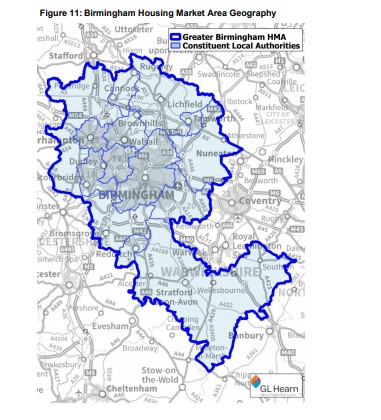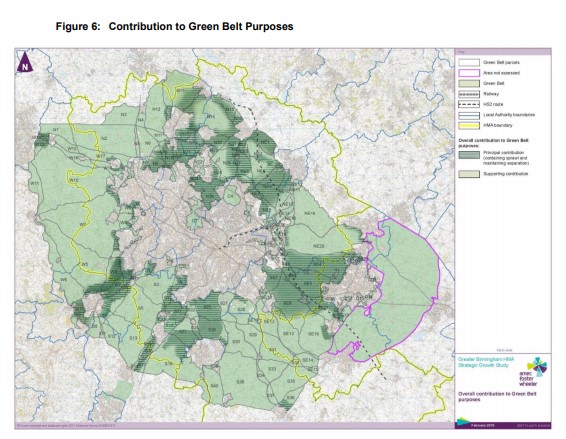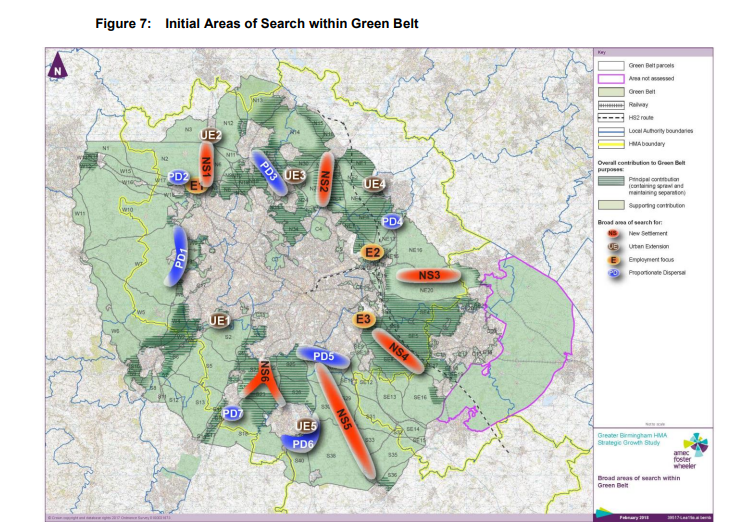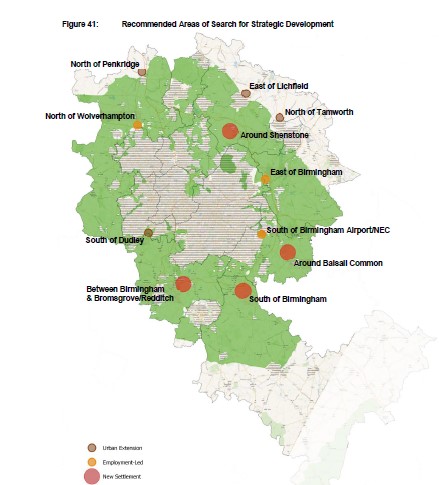Greater Birmingham HMA Strategic Growth Study

In February 2018, the Greater Birmingham HMA Strategic Growth Study prepared by GL Hearn and Wood Plc was published. We provide a summary of the key findings of the report.
Birmingham’s functional HMA covers more than Birmingham and includes the Black Country and parts of Worcestershire, Warwickshire and Staffordshire. It also covers authorities which are within the Greater Birmigham and Solihull LEP and the Black Country LEP. North Warwickshire and Stratford-on-Avon Districts are authorities with an area of overlap between the Birmingham and Coventry/Warwickshire HMA.
The study’s four main aims are:
- Review of existing identified supply to consider whether, by positively applying policies that are consistent for each type of site across the HMA, more dwellings could be provided through increased densities.
- Consider the potential additional supply on other land outside of the Green Belt that has not been previously considered for housing development
- If a shortfall remains after aim 1 & 2, to then consider the development potential and suitability of any large previously developed sites within the Green Belt that may lie in sustainable locations.
- Should a shortfall remain after undertaking tasks (1) to (3), undertake a full strategic review of the Green Belt within the HMA utilising a consistent Green Belt Review methodology, which assesses Green Belt against its five purposes.
”Whilst a single plan is not being prepared, housing need is a strategic issue which the HMA authorities need to collaborate in addressing through the Duty to Cooperate”.
Objectively Assessed Need
Existing Evidence Base
The report looks at the findings already published by local authorities as follows and also reviews the housing requirements within the adopted plans There is a 38,000 dwelling unmet need arising from the Birmingham Development Plan to 2031. In addition, there is an unmet need from Tamworth (1,825 dwellings to 2031) and Cannock Chase (500 dwellings to 2028).
| Local Authority | OAN | Plan period | Housing requirement | Shortfall |
| Birmingham | 89,000 | 2011-2031 | 51000 | -38,00 |
| Bromsgrove | 6,648 | (2011-2030) | 7000 | 0 |
| Cannock Chase | 5300 | 2006-2028 | 5300 | -500 |
| Lichfield | 8600 | 2008-2029 | 10,030 | 0 |
| Redditch | 6400 | 2011-2030 | 6400 | 0 |
| Solihull | 14,277 | 2014-2033 | 15029 | |
| Tamworth | 6250 | 2006-2031 | 4425 | -1,825 |
| Warwickshire | 3150 | 2011-2029 | 9070 | |
| Stratford on Avon | 14,600 | 2011-2031 | 14600 | |
| Black Country | 78,190 | 2014-2036 | 63000 | |
| South Staffordshire | 5933 | 2014-2036 | 3850 | |
| HMA total | 11,500 |
Projections
The GL Hearn assessment of OAN has been considered using four projections:
Economic Projections
Economy Plus Scenario
The Economy plus is a scenario modelled in the Strategic Economic Plan for further and faster growth than predicted in the three LEP Strategic Economic Plans. This is an aspirational ‘policy on’ scenario based on a policy aspiration to improve economic performance.
The West Midland Strategic Economic Plan is based on the economy plus scenario( as set out in the West Midlands Combined Authority’s Strategic Economic Plan) up to 2036 this scenario suggests a requirements for 310,188 dwellings.
Baseline Economic Growth
The baseline economic growth projection is based on a continuation of past trends, but takes into account how different economic sectors are expected to perform in the future (relative to the past). It should be regarded as ‘policy neutral’. Up to 2036 this projection suggests a need for 240,012 dwellings
Demographic Projections
There are three demographic projections that the report considers:
2014 Based Subnational Population Projections
These were the latest official, 2014-based, Household Projections, which Government’s Planning Practice Guidance identifies as the ‘starting point’ for quantifying OAN and suggests 255,533 dwellings required to 2036.
Rebased Sub National Population Projections
The rebased SNPP rebases the 2014-based Population and Household Projections to take account of population growth between 2014-15 shown in ONS Mid-Year Population Estimates. This projection suggests a requirement for 254,873 dwellings to 2036 .
10 year Migration
The 10 year migration projection considers the difference between the trends in migration over the input period to the SNPP (the 5 years to 2014 for domestic and 6 years for international migration) and those over a 10 year period (2005-15), and then adjusts future trends in migration based on the difference between these. This projection shows a requirement for 251, 647 dwellings up to 2036.
Government Standardised Approach
The report also considers the Governments standardised approach to OAN which is to use latest official projections, with adjustments then applied based on the degree to which the affordability ratio is over 4, with a 1% increase in the ratio of median house prices to earnings over.
The report envisages a cap which is 40% above existing local plan figures where the local plan was adopted in the previous 5 years; or 40% above either the latest local plan or the household projections (whichever is the higher) where there is not an up-to-date local plan.
The uncapped need figures arising from this approach align broadly with the demographic baseline position to 2031, showing a need for 207,000 homes. To 2036 the uncapped need is for 265,000 homes which is around 4% above the demographic need shown by the projections within the report.
Unmet Needs
North Warwickshire and Stratford-on-Avon have agreed to make provision for Coventry’s unmet housing needs. North Warwickshire is contributing 860 dwellings to meeting Coventry’s unmet needs to 2031 and 2,020 dwellings from Stratford-on-Avon, totalling 2,880 dwellings. If this was rolled forward to 2036 on a pro-rata basis, this would be 3,600 dwellings.
“GL Hearn conclude that on the basis of the current evidence provision of between 205,000 – 246,000 homes is needed across the Birmingham HMA to 2031; and provision of between 256,000 – 310,000 homes to 2036 (from a 2011 baseline) to meet the Birmingham HMA’s housing needs and taking account of Coventry’s unmet need of 208,000 dwellings to 2031 and 258,500 homes to 2036”.
Land Supply
Shortfall
GL Hearn’s initial information submitted indicated a land supply of around 203,000 dwellings to 2036, of which 200,000 dwellings could be delivered over the period to 2031.
This is made up of
- Completions –
- Sites with Planning Permissions (i.e. Commitments) –
- Extant Allocations without Planning Consent
- Allocations in Emerging Plans
- Additional Urban Supply
- Windfalls
Land supply by Authority
Birmingham (April 2016):A total land supply for 51,458 dwellings is identified to 2031 and 59,858 to 2036.
Bromsgrove (April 2017): A total land supply of 5,099 dwellings is identified to 2031 and 5,299 dwellings to 2036.
Cannock Chase (April 2016): A total land supply of 4,615 dwellings is identified to 2031 and 4,685 dwellings to 2036.
Dudley (April 2016): A total land supply of 17,918 dwellings is identified to 2031 and 18,668 dwellings to 2036.
Lichfield( August 2017): A total land supply of 10,973 dwellings is identified to 2031 and 11,248 dwellings to 2036.
North Warkwickshire (April 2017): A total land supply of 9,060 dwellings is identified to 2031 and 9,360 dwellings to 2036. This includes making specific provision to meet an unmet need for 4,410 dwellings from other parts of the Birmingham HMA, as identified in Section 3 as well as 860 dwellings unmet need from Coventry.
Redditch (April 2017): 7,488 dwellings to 2031 and 7,543 dwellings to 2036.
Sandwell (April 2016): 19,930 dwellings is identified to 2031 and 20,813 dwellings to 2036. The land supply has been assessed to 2036.
Solihull (April 2016): 5,717 dwellings to 2031 and 16,945 dwellings to 2036 including specific provision for a contribution of 2,000 dwellings to meeting unmet needs of the Birmingham HMA.
South Staffordshire (April 2017): 3,493 dwellings to 2031 and 3,643 dwellings to 2036
Stratford-on-Avon (April 2016):16,713 dwellings to 2031 and 19,358 dwellings to 2036
Tamworth (April 2017): 4,495 dwellings to 2031 and 4,680 dwellings to 2036.
Walsall (April 2017): 10,879 dwellings to 2031 and 11,284 dwellings to 2036.
Wolverhampton (April 2016):13,816 dwellings to 2031 and 16,495 dwellings to 2036.
Following the submission of the initial information, adjustments were made to ensure consistency with the windfall approach and non implementation discounts.
Approaches to Delivery
Existing Sites
The report explores in detail approaches to be taken to providing additional land to be identified within urban areas including brownfield land, disposing of surplus public sector land, estate regeneration, town centre regeneration and disposing of surplus open space. The report also assesses in detail the potential to increase densities across the HMA and concludes that it would be reasonable to assume minimum densities of 40 dph are achieved in the conurbation (Birmingham and the Black Country urban area), with minimum densities of 35 dph in other parts of the HMA. This approach would yield additional supply of 13,000 dwellings, principally over the period to 2031.
Identifying and Allocating Additional Land
Taking into account the potential housing supply which could be achieved by increasing densities, there remains a need to identify capable of supporting delivery of over 15,000 homes to 2031, and a total of over 47,800 homes to 2036. Additional land needs to be identified and allocated to meet this. This provides a clear basis for progressing a strategic review of the Birmingham Green Belt.
Given the scale of unmet need, the report focuses on strategic development options as follows:
- Urban Extensions (1,500 – 7,500 dwellings);
- Employment-led Strategic Development (1,500 – 7,500 dwellings); and
- New Settlements (10,000+ dwellings). –
Potential Areas of Search for Strategic Development beyond the Green Belt
South Staffordshire
- Urban Extension: North of Penkridge
- Urban Extension: South of Stafford
- New Settlement: Around Dunston
Lichfield
The Study initially identifies three potential Areas of Search for Strategic Development:
- Urban Extension: East of Lichfield
- Urban Extension: North of Tamworth
- New Settlement: Around Fradley and Alrewas
North Warwickshire
One potential Area of Search for Strategic Development is identified to be tested: Urban Extension: East of Polesworth
Within the HMA, the only location which has been identified by Government for new strategic development is Long Marston, which is designated a Garden Village. Consideration has therefore been given to the potential for enhanced strategic development in this broad area.
The potential Areas of Search for strategic development identified to be tested are thus:
- Urban Extension: South of Stratford-upon-Avon town
- New Settlement: Around Wellesbourne
- New Settlement: South-West of Stratford-upon-Avon District
Potential Areas of Search in the Green Belt
The Study undertook a Strategic Green Belt Review, assessing the form and strategic function of the Green Belt against the purposes of Green Belt policy set out in the National Planning Policy Framework (NPPF) (Para 80).

Four spatial development models were created:
- New settlements
- Scale attracts greater opportunity for central government investment
- Urban Extensions
- Lead in times of typically 5+ years
- Larger and more costly infrastructure requirements
- Employment focus
- Lead in times of 3-5 years
- Larger infrastructure requirements
- Proportionate Dispersal
- These have the shortest lead in times and have typically lower requirements for strategic infrastructure
Six Areas of Search for new settlements and six for urban extensions are identified; together with three Areas of Search for employment-led development.

Recommended Areas of Search for Strategic Development
Employment-Led
- I54
- East of Birmingham
- Birmingham Airport/ NEC
These Areas of Search have the following characteristics:
- Strategic employment areas with a key employer and/or clustering of employers
- Likely to be located adjacent to, or in the vicinity of, a Motorway junction.
- Potential to support some housing provision as part of mixed-use development (1,500 to 7,500 dwellings).
Urban Extensions
The Study concludes that the strongest performing Urban Extension options which should be taken forward for more detailed consideration by the HMA authorities are:
- South of Dudley
- North of Tamworth
- East of Lichfield
- North of Penkridge.
New Settlements
The report recommends the following areas of search should be taken forward:
- South of Birmingham
- Between Birmingham and Bromsgrove/Redditch
- Around Shenstone
- Around Balsall Common

Summary
There is a minimum housing need for 205000 up to 2031 and 255,000 up to 2036. Taking into account shortfalls this increases to 208,000 up to 2031 and 258,00 to 2036.
The current evidence suggests provision of between 205,000 – 246,000 homes across the Birmingham HMA to 2031; and 256,000 – 310,000 homes to 2036.
There is a developable land supply of 180,000 to 2031 and 197,000 to 2036. Bringing together the need and currently identified supply, there is an outstanding minimum shortfall of 28,150 dwellings to 2031 and 60,900 dwellings to 2036 across the Birmingham HMA.
New strategic allocations will be required to address this shortfall across the whole HMA.
Next Steps
It is envisaged that further technical and feasibility work will be underway to assess the suitability of the areas of search as identified by the report along with a process of iterative Masterplanning and consultation with local residents.





